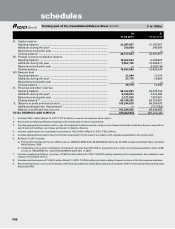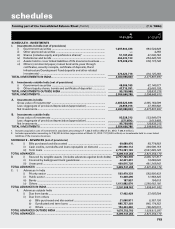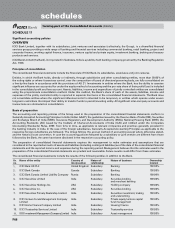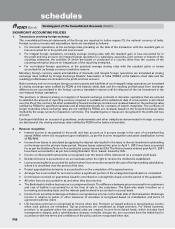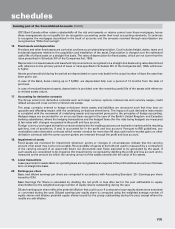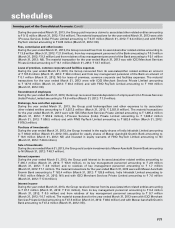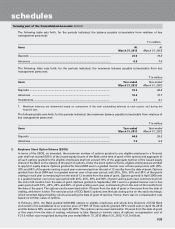ICICI Bank 2013 Annual Report Download - page 147
Download and view the complete annual report
Please find page 147 of the 2013 ICICI Bank annual report below. You can navigate through the pages in the report by either clicking on the pages listed below, or by using the keyword search tool below to find specific information within the annual report.
F69
•In the case of general insurance business, premium is recorded for the policy period at the commencement of risk
and for instalment cases, it is recorded on instalment due dates. Premium earned is recognised as income over
the period of the risk or the contract period based on 1/365 method, whichever is appropriate, on a gross basis,
net of service tax. Any subsequent revision to premium is recognised over the remaining period of risk or contract
period. Adjustments to premium income arising on cancellation of policies are recognised in the period in which
the policies are cancelled. Commission on re-insurance ceded is recognised as income in the period of ceding the
risk. Profit commission under re-insurance treaties, wherever applicable, is recognised as income in the period of
final determination of profits and combined with commission on reinsurance ceded.
•In the case of general insurance business, insurance premium on ceding of the risk is recognised in the period in
which the risk commences. Any subsequent revision to premium ceded is recognised in the period of such revision.
Adjustment to re-insurance premium arising on cancellation of policies is recognised in the period in which they are
cancelled. In case of life insurance business, cost of reinsurance ceded is accounted for at the time of recognition
of premium income in accordance with the treaty or in-principle arrangement with the reinsurer. Profit commission
on reinsurance ceded is netted off against premium ceded on reinsurance.
•In the case of general insurance business, premium deficiency is recognised when the sum of expected claim costs
and related expenses and maintenance costs exceed the reserve for unexpired risks and is computed at a business
segment level.
3. Stock based compensation
The following entities within the group have granted stock options to their employees:
•ICICI Bank Limited
•ICICI Prudential Life Insurance Company Limited
•ICICI Lombard General Insurance Company Limited
The Employees Stock Option Scheme (the Scheme) provides for grant of option on equity shares of the Bank to
wholetime directors and employees of the Bank and its subsidiaries. The Scheme provides that employees are granted
an option to subscribe to equity shares of the Bank that vest in a graded manner. The options may be exercised within
a specified period. ICICI Prudential Life Insurance Company and ICICI Lombard General Insurance Company have also
formulated similar stock option schemes for their employees for grant of equity shares of their respective companies.
The Group follows the intrinsic value method to account for its stock-based employee compensation plans. Compensation
cost is measured as the excess, if any, of the fair market price of the underlying stock over the exercise price on the grant
date and amortised over the vesting period. The fair market price is the latest closing price, immediately prior to the
grant date, which is generally the date of the Board of Directors meeting in which the options are granted, on the stock
exchange on which the shares of the Bank are listed. If the shares are listed on more than one stock exchange, then the
stock exchange where there is highest trading volume on the said date is considered. In the case of ICICI Prudential Life
Insurance Company and ICICI Lombard General Insurance Company, the fair value of the shares is determined based on
an external valuation report. The banking subsidiaries namely, ICICI Bank UK and ICICI Bank Canada account for the cost
of the options granted to employees by ICICI Bank using the fair value method based on binomial tree model.
4. Income taxes
Income tax expense is the aggregate amount of current tax and deferred tax expense incurred by the Group. The current
tax expense and deferred tax expense is determined in accordance with the provisions of the Income Tax Act, 1961
and as per Accounting Standard 22 - Accounting for Taxes on Income, respectively. Deferred tax adjustments comprise
changes in the deferred tax assets or liabilities during the year.
Deferred tax assets and liabilities are recognised by considering the impact of timing differences between taxable
income and accounting income for the current year, and carry forward losses. Deferred tax assets and liabilities are
measured using tax rates and tax laws that have been enacted or substantively enacted at the balance sheet date. The
impact of changes in the deferred tax assets and liabilities is recognised in the profit and loss account.
Deferred tax assets are recognised and re-assessed at each reporting date, based upon the management’s judgement
as to whether their realisation is considered as reasonably certain. However, where there is unabsorbed depreciation or
carried forward loss under taxation laws, deferred tax assets are recognised only if there is virtual certainty of realisation
of such assets.
In the consolidated financial statements, deferred tax assets and liabilities are computed at an individual entity level and
aggregated for consolidated reporting.
5. Claims and benefits paid
In the case of general insurance business, claims incurred comprise claims paid, estimated liability for outstanding
claims made following a loss occurrence reported and estimated liability for claims incurred but not reported (IBNR) and
claims incurred but not enough reported (IBNER). Further, claims incurred also include specific claim settlement costs
forming part of the Consolidated Accounts (Contd.)
schedules



